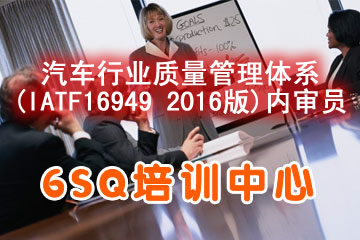第九十篇 The Future of ISO 9001
本帖最后由 小编D 于 2013-3-12 15:17 编辑
请对以下文章有翻译兴趣的组员留下你的预计完成时间和邮箱地址,以便小编登记翻译者信息以及文章最终完成时间
本文翻译:muddy533 校稿:spear
The Future of ISO 9001
ISO 9001的未来
Business management literature’s most influential work?
业务管理著作是最具有影响力的作品吗?
To remain the valuable business system that it currently is, ISO 9001 needs to continue to evolve, ensuring that organizations of all sizes, complexities, and locations see a clear connection between their strategic objectives and their quality management system (QMS) . It is not just about meeting the requirements of a standard to get certification; ISO 9001 must be embedded in everything that the organization does.
为了保持业务体系现有的价值,ISO9001需要持续发展,以确保各种规模、各种复杂程度乃至各种地方的组织能清晰地认识到他们的战略目标与他们的质量管理体系(QMS)之间的联系。这不仅仅是为了得到认证而满足一个标准的要求;ISO9001需要融入组织所做的每一件事情当中去。
A defining moment
一个划时代的时刻
In 2000, there were far-reaching changes made to ISO 9001, the international QMS standard. These changes were based on an extensive International Organization for Standardization (ISO) user survey but were also made at a time of widespread criticism of the standard and the third-party certification industry. The resulting changes proved to be a defining moment, resulting in a clear “before and after.” Prior to 2000, ISO 9001 was purely a conformity assessment standard; however, following the changes, which were rooted in key quality management principles, the standard became not only this but also a framework for managing and assessing organizations against accepted management best practices.
2000年的时候,ISO9001这个国际化的质量管理体系(QMS)标准发生了深刻的变化。这些深刻的变化基于对ISO标准使用者的广泛调查的基础之上,同时也发生在对这个标准以及第三方认证行业的广泛诟病的时候。变化的结果证明了这是一个划时代的时刻,描绘了一个清晰的“此前与之后”。2000年以前,ISO9001纯粹只是一个符合性评价的标准;然而,随着源于关键质量管理原则的变化,这个标准变得不仅仅是这样了,而是成为了管理和评价组织在公认管理之前的最好实践框架。
In fact, given that now more than one million organizations in more than 150 countries use the standard to manage their key value-creating processes, it’s arguably the most influential piece of business management literature ever written.
事实上,由于当今涵盖150多个国家、超过100多万个组织采用这个标准来管理他们的关键价值创造过程,它(ISO9001标准)毫无争议的成为了业务管理著作中有史以来最有影响力的一个。
Uncovering an organization’s self-knowledge
揭示了组织的自我认识
The changes not only raised the bar for the companies using the standard but also for the third-party certification industry that conducts the independent assessments.
这个变化不仅仅为公司采用ISO9001标准的扫清了障碍,也为第三方认证行业执行独立的评估清除了壁垒。
Assessor competence defines the certification industry. Assessors not only need to understand the industries they work in and the businesses they assess but also must be able to apply this knowledge in a way that unlocks the intrinsic value in the assessment process. They must be able to speak both the language of the shop floor and that of the boardroom.
审核员的能力决定了认证的行业。审核员不仅需要理解他们所为之工作的行业以及他们所评价的业务,还必须有能力用一种在评价过程中揭示内在价值的方式应用这些知识。他们必须既能讲工厂车间的语言,同时还能讲会议室的语言。
Independence and transparency are of pivotal importance to the certification industry; as providers of certification, we add value through structured and measured questioning, known as Socratic questioning. This provides assurance to our clients, their customers, and the larger group of stakeholders in society. This is not the same as consultancy which strives to add value through the provision of expert advice.
独立性和透明度对于认证行业来说是至关重要的;对于认证的提供者,正如为人所熟知的苏格拉底式的提问那样,我们通过结构化和测量性的提问来增值。这为我们的客户、他们的顾客以及大型上市公司的股东们提供保证。这和努力通过提供专业意见来增值的咨询行业是不一样的。
Accreditation’s role认可的作用
认证的角色
Transparent and credible governance of certification bodies through the accreditation process should remain at the heart of independent assessment and certification. It is central to stakeholder confidence by ensuring the competence of assessors and the impartiality of the decision-making process are maintained.
在整个认证过程中对认证机构的透明度和可靠性管理是保持独立评价和认证的核心。通过确保审核员的能力和决策过程的公正性来保证信心对股东来说是中心问题。
The speed and growth of ISO 9001 certification, coupled with the evolution of management systems standards, have also required changes in the accreditation process—changes that are reflected in today’s accreditation system.
ISO9001认证的成长和快速发展,伴随着管理体系标准的演变,在认证过程中也要求变化——反映在当今认证体系中的变化。
ISO/IEC 17021:2011 is the standard for certification bodies. It ensures that the regional or country-specific accreditation bodies, such as the United Kingdom Accreditation Service (UKAS) and ANSI-ASQ National Accreditation Board (ANAB), assess the certification industry against a consistent standard. ISO/IEC 17021 has also extended the competence requirements to encompass all staff engaged in the certification process. For these reasons the standard offers tangible, consistent benefits that translate into increased trust and confidence for all stakeholder groups.
ISO/IEC 17021:2011是一个关于认证机构的标准。其确保地区性的或者特定国家的认证机构,诸如联合王国认可服务(UKAS)和ANSI-ASQ国家认可委员会(ANAB),在一个统一的标准下评估认证行业。ISO/IEC 17021同时还扩展了包含认证过程中所有参与人员在内的能力要求。基于这些原因,这个标准为所有的股东群体提供切实的、统一的利益,即日渐增长的信赖与信心。
Matching business developments与业务发展相匹配
When ISO 9001:2000 was revised, one of the key changes was more generic language to extend its use into service activities as well as manufacturing. This change, particularly in industries that are highly concentrated and where there is a high degree of specialization, has meant that customized versions of the ISO 9001 standard have become more attractive. Rather than point to any deficiencies in ISO 9001, sector-specific versions for the automotive, food, and aerospace industries are a testament to the management principles that underpin the standard, supported by its acknowledged capability to solve quality problems.
在ISO 9001:2000版修订的时候,其中一项关键变化就是将统一化的语言延伸到了服务活动以及制造活动中。这些变化,特别是在被高度关注的行业以及高度专业化的行业内,意味着ISO 9001标准的用户化版本更受关注了。不像ISO9001所指出的任何不足,汽车、食品以及航空工业的专业化版本是加强该标准的管理原则的证明,这是由他公认的解决质量问题的能力决定的。
The revision process for ISO 9001 is just beginning and will be subject to a number of different influences, including the latest ISO user’s survey and the inevitable tension in the voting phase between those who want radical change vs. a more evolutionary approach. Given the minimal nature of the changes in 2008, there needs to be some meaningful change. Otherwise, come 2015, the standard will not have significantly changed in 15 years. This could mean that it lags so far behind today’s modern business practice that its relevance could be called into question.
ISO9001的修订过程只是一个开始,必将受到大量的各种影响,包括最近的ISO用户的调查和在激进派和改良派之间的投票表决方面的不可避免的压力。假定2008年的变化是最小的本质上的变化,那就需要更多的有意义的改变了。否则,到直到2015年,这个标准在15年内就不会有显著的变化了。这可能意味着标准将远远落后于当今的商业活动,并且标准的适用性将会产生大问题。
Possible changes ahead今后可能的变化
With the existing agreement on the common structure and text for future revisions on all ISO management systems standards, there is room for speculation about likely changes for the next version of ISO 9001. For instance, acknowledging the fundamental purpose of all management systems standards, currently numbering in excess of 40, is to prevent things from going wrong. Therefore, if prevention is to become the defining purpose of an ISO 9001 management system, this must inevitably lead to the consideration of risk; not a risk management system that focuses solely on risk, but the systematic control of risk through the management system, which is subtly different.
对于各种ISO管理体系标准的未来修订版本而言在一般结构及文字上存在共识,存在对ISO9001的下一个版本可能进行修改的空间。比如,已知的所有管理体系标准的最基本的目标目前共计已经超过了40个,这就可以避免事情往坏的方向发展。因此,如果预防成为定义一个ISO9001管理体系的目的,这就必然导致对风险的考虑。并不是只有单一的风险管理体系会聚焦风险,对贯穿管理体系的风险的系统控制也会关注风险,这就是微妙的不同之处。
Another area links into the changes in modern organizational design. One of the changes in the modern business world has been the breaking down of traditional organizational boundaries from vertically integrated companies to whole industries characterized by outsourcing, thereby creating “demand networks” commonly referred to as supply chains. The collaborative, interdependent nature of the way in which these relationships are managed should be addressed in the new version of the standard.
另一个领域与现代组织的设计中的变化相联系。当今商业世界的变化之一就是从垂直整合的公司到具备外包特性的整体化行业已经打破了传统的组织边界,因此,创造“需求网络”就通常作为供应链来参考。这种用来管理关系的方式的协作性与独立性的本质需要在标准的新版本中加以描述。
Finally, the common text and structure must define the need for an organization to consider changes relative to both its external and internal environment. This will focus the organization and its certification body on aligning its quality objectives within its overall strategic goals.
最后,标准的一般文本和结构必须定义组织对有关其内外部环境变化的需要,这将关注组织及认证机构在其整体战略目标内的质量目标的联合。
Into the future进入未来
There have been numerous independent studies over the years demonstrating the benefits of implementing ISO 9001; one such study was published in a peer-reviewed academic journal from Harvard Business School. The article encapsulates some of the key organizational benefits for ISO 9001 certification, stating: “ISO adopters have higher rates of corporate survival, sales, and employment growth.”
近年有大量独立的关于论证运行ISO9001标准收益的研究。有这样一篇论文发表在哈佛商学院的一个权威的学术期刊上。这篇文章浓缩了一些ISO9001认证的组织所取得的关键收益,它这样写道:“采用ISO的组织在公司生存、销售额及雇员增长上都有更高的比率。”
The ISO 9001:2000 update was the most significant evolutionary step to date. Internal and external QMS stakeholders await the direction the next ISO 9001 update will take.
ISO9001:2000的更新是到目前为止最重要的革命。内部和外部的QMS利益相关方正期待着ISO9001的再次更新的指南。
Robust and relevant services, products that inspire confidence and drive organizational resilience, and competitive advantage and growth are the real values in independent assessment. With that goal in mind, the certification industry, through innovation, independence, training, and the technical expertise of assessors, represents a valuable service to the business world and society, both today and into the future.
激发信心并促使组织存活的重大而有实质意义的服务、产品以及竞争优势和成长都是在独立评估中的真正价值所在。脑海中有了这些目标,认证行业通过创新、自立、培训以及审核员的技术技能来为商业世界和社会提供有价值的服务,不管是今天还是未来。
About The Author关于作者
Mike James麦克 詹姆斯
Mike James is the managing director at Lloyd’s Register Quality Assurance (LRQA) .
麦克 詹姆斯是LRQA的管理主席。
请对以下文章有翻译兴趣的组员留下你的预计完成时间和邮箱地址,以便小编登记翻译者信息以及文章最终完成时间
本文翻译:muddy533 校稿:spear
The Future of ISO 9001
ISO 9001的未来
Business management literature’s most influential work?
业务管理著作是最具有影响力的作品吗?
To remain the valuable business system that it currently is, ISO 9001 needs to continue to evolve, ensuring that organizations of all sizes, complexities, and locations see a clear connection between their strategic objectives and their quality management system (QMS) . It is not just about meeting the requirements of a standard to get certification; ISO 9001 must be embedded in everything that the organization does.
为了保持业务体系现有的价值,ISO9001需要持续发展,以确保各种规模、各种复杂程度乃至各种地方的组织能清晰地认识到他们的战略目标与他们的质量管理体系(QMS)之间的联系。这不仅仅是为了得到认证而满足一个标准的要求;ISO9001需要融入组织所做的每一件事情当中去。
A defining moment
一个划时代的时刻
In 2000, there were far-reaching changes made to ISO 9001, the international QMS standard. These changes were based on an extensive International Organization for Standardization (ISO) user survey but were also made at a time of widespread criticism of the standard and the third-party certification industry. The resulting changes proved to be a defining moment, resulting in a clear “before and after.” Prior to 2000, ISO 9001 was purely a conformity assessment standard; however, following the changes, which were rooted in key quality management principles, the standard became not only this but also a framework for managing and assessing organizations against accepted management best practices.
2000年的时候,ISO9001这个国际化的质量管理体系(QMS)标准发生了深刻的变化。这些深刻的变化基于对ISO标准使用者的广泛调查的基础之上,同时也发生在对这个标准以及第三方认证行业的广泛诟病的时候。变化的结果证明了这是一个划时代的时刻,描绘了一个清晰的“此前与之后”。2000年以前,ISO9001纯粹只是一个符合性评价的标准;然而,随着源于关键质量管理原则的变化,这个标准变得不仅仅是这样了,而是成为了管理和评价组织在公认管理之前的最好实践框架。
In fact, given that now more than one million organizations in more than 150 countries use the standard to manage their key value-creating processes, it’s arguably the most influential piece of business management literature ever written.
事实上,由于当今涵盖150多个国家、超过100多万个组织采用这个标准来管理他们的关键价值创造过程,它(ISO9001标准)毫无争议的成为了业务管理著作中有史以来最有影响力的一个。
Uncovering an organization’s self-knowledge
揭示了组织的自我认识
The changes not only raised the bar for the companies using the standard but also for the third-party certification industry that conducts the independent assessments.
这个变化不仅仅为公司采用ISO9001标准的扫清了障碍,也为第三方认证行业执行独立的评估清除了壁垒。
Assessor competence defines the certification industry. Assessors not only need to understand the industries they work in and the businesses they assess but also must be able to apply this knowledge in a way that unlocks the intrinsic value in the assessment process. They must be able to speak both the language of the shop floor and that of the boardroom.
审核员的能力决定了认证的行业。审核员不仅需要理解他们所为之工作的行业以及他们所评价的业务,还必须有能力用一种在评价过程中揭示内在价值的方式应用这些知识。他们必须既能讲工厂车间的语言,同时还能讲会议室的语言。
Independence and transparency are of pivotal importance to the certification industry; as providers of certification, we add value through structured and measured questioning, known as Socratic questioning. This provides assurance to our clients, their customers, and the larger group of stakeholders in society. This is not the same as consultancy which strives to add value through the provision of expert advice.
独立性和透明度对于认证行业来说是至关重要的;对于认证的提供者,正如为人所熟知的苏格拉底式的提问那样,我们通过结构化和测量性的提问来增值。这为我们的客户、他们的顾客以及大型上市公司的股东们提供保证。这和努力通过提供专业意见来增值的咨询行业是不一样的。
Accreditation’s role认可的作用
认证的角色
Transparent and credible governance of certification bodies through the accreditation process should remain at the heart of independent assessment and certification. It is central to stakeholder confidence by ensuring the competence of assessors and the impartiality of the decision-making process are maintained.
在整个认证过程中对认证机构的透明度和可靠性管理是保持独立评价和认证的核心。通过确保审核员的能力和决策过程的公正性来保证信心对股东来说是中心问题。
The speed and growth of ISO 9001 certification, coupled with the evolution of management systems standards, have also required changes in the accreditation process—changes that are reflected in today’s accreditation system.
ISO9001认证的成长和快速发展,伴随着管理体系标准的演变,在认证过程中也要求变化——反映在当今认证体系中的变化。
ISO/IEC 17021:2011 is the standard for certification bodies. It ensures that the regional or country-specific accreditation bodies, such as the United Kingdom Accreditation Service (UKAS) and ANSI-ASQ National Accreditation Board (ANAB), assess the certification industry against a consistent standard. ISO/IEC 17021 has also extended the competence requirements to encompass all staff engaged in the certification process. For these reasons the standard offers tangible, consistent benefits that translate into increased trust and confidence for all stakeholder groups.
ISO/IEC 17021:2011是一个关于认证机构的标准。其确保地区性的或者特定国家的认证机构,诸如联合王国认可服务(UKAS)和ANSI-ASQ国家认可委员会(ANAB),在一个统一的标准下评估认证行业。ISO/IEC 17021同时还扩展了包含认证过程中所有参与人员在内的能力要求。基于这些原因,这个标准为所有的股东群体提供切实的、统一的利益,即日渐增长的信赖与信心。
Matching business developments与业务发展相匹配
When ISO 9001:2000 was revised, one of the key changes was more generic language to extend its use into service activities as well as manufacturing. This change, particularly in industries that are highly concentrated and where there is a high degree of specialization, has meant that customized versions of the ISO 9001 standard have become more attractive. Rather than point to any deficiencies in ISO 9001, sector-specific versions for the automotive, food, and aerospace industries are a testament to the management principles that underpin the standard, supported by its acknowledged capability to solve quality problems.
在ISO 9001:2000版修订的时候,其中一项关键变化就是将统一化的语言延伸到了服务活动以及制造活动中。这些变化,特别是在被高度关注的行业以及高度专业化的行业内,意味着ISO 9001标准的用户化版本更受关注了。不像ISO9001所指出的任何不足,汽车、食品以及航空工业的专业化版本是加强该标准的管理原则的证明,这是由他公认的解决质量问题的能力决定的。
The revision process for ISO 9001 is just beginning and will be subject to a number of different influences, including the latest ISO user’s survey and the inevitable tension in the voting phase between those who want radical change vs. a more evolutionary approach. Given the minimal nature of the changes in 2008, there needs to be some meaningful change. Otherwise, come 2015, the standard will not have significantly changed in 15 years. This could mean that it lags so far behind today’s modern business practice that its relevance could be called into question.
ISO9001的修订过程只是一个开始,必将受到大量的各种影响,包括最近的ISO用户的调查和在激进派和改良派之间的投票表决方面的不可避免的压力。假定2008年的变化是最小的本质上的变化,那就需要更多的有意义的改变了。否则,到直到2015年,这个标准在15年内就不会有显著的变化了。这可能意味着标准将远远落后于当今的商业活动,并且标准的适用性将会产生大问题。
Possible changes ahead今后可能的变化
With the existing agreement on the common structure and text for future revisions on all ISO management systems standards, there is room for speculation about likely changes for the next version of ISO 9001. For instance, acknowledging the fundamental purpose of all management systems standards, currently numbering in excess of 40, is to prevent things from going wrong. Therefore, if prevention is to become the defining purpose of an ISO 9001 management system, this must inevitably lead to the consideration of risk; not a risk management system that focuses solely on risk, but the systematic control of risk through the management system, which is subtly different.
对于各种ISO管理体系标准的未来修订版本而言在一般结构及文字上存在共识,存在对ISO9001的下一个版本可能进行修改的空间。比如,已知的所有管理体系标准的最基本的目标目前共计已经超过了40个,这就可以避免事情往坏的方向发展。因此,如果预防成为定义一个ISO9001管理体系的目的,这就必然导致对风险的考虑。并不是只有单一的风险管理体系会聚焦风险,对贯穿管理体系的风险的系统控制也会关注风险,这就是微妙的不同之处。
Another area links into the changes in modern organizational design. One of the changes in the modern business world has been the breaking down of traditional organizational boundaries from vertically integrated companies to whole industries characterized by outsourcing, thereby creating “demand networks” commonly referred to as supply chains. The collaborative, interdependent nature of the way in which these relationships are managed should be addressed in the new version of the standard.
另一个领域与现代组织的设计中的变化相联系。当今商业世界的变化之一就是从垂直整合的公司到具备外包特性的整体化行业已经打破了传统的组织边界,因此,创造“需求网络”就通常作为供应链来参考。这种用来管理关系的方式的协作性与独立性的本质需要在标准的新版本中加以描述。
Finally, the common text and structure must define the need for an organization to consider changes relative to both its external and internal environment. This will focus the organization and its certification body on aligning its quality objectives within its overall strategic goals.
最后,标准的一般文本和结构必须定义组织对有关其内外部环境变化的需要,这将关注组织及认证机构在其整体战略目标内的质量目标的联合。
Into the future进入未来
There have been numerous independent studies over the years demonstrating the benefits of implementing ISO 9001; one such study was published in a peer-reviewed academic journal from Harvard Business School. The article encapsulates some of the key organizational benefits for ISO 9001 certification, stating: “ISO adopters have higher rates of corporate survival, sales, and employment growth.”
近年有大量独立的关于论证运行ISO9001标准收益的研究。有这样一篇论文发表在哈佛商学院的一个权威的学术期刊上。这篇文章浓缩了一些ISO9001认证的组织所取得的关键收益,它这样写道:“采用ISO的组织在公司生存、销售额及雇员增长上都有更高的比率。”
The ISO 9001:2000 update was the most significant evolutionary step to date. Internal and external QMS stakeholders await the direction the next ISO 9001 update will take.
ISO9001:2000的更新是到目前为止最重要的革命。内部和外部的QMS利益相关方正期待着ISO9001的再次更新的指南。
Robust and relevant services, products that inspire confidence and drive organizational resilience, and competitive advantage and growth are the real values in independent assessment. With that goal in mind, the certification industry, through innovation, independence, training, and the technical expertise of assessors, represents a valuable service to the business world and society, both today and into the future.
激发信心并促使组织存活的重大而有实质意义的服务、产品以及竞争优势和成长都是在独立评估中的真正价值所在。脑海中有了这些目标,认证行业通过创新、自立、培训以及审核员的技术技能来为商业世界和社会提供有价值的服务,不管是今天还是未来。
About The Author关于作者
Mike James麦克 詹姆斯
Mike James is the managing director at Lloyd’s Register Quality Assurance (LRQA) .
麦克 詹姆斯是LRQA的管理主席。
没有找到相关结果
已邀请:





7 个回复
muddy533 (威望:0) (黑龙 哈尔滨) 机械制造 员工
赞同来自: